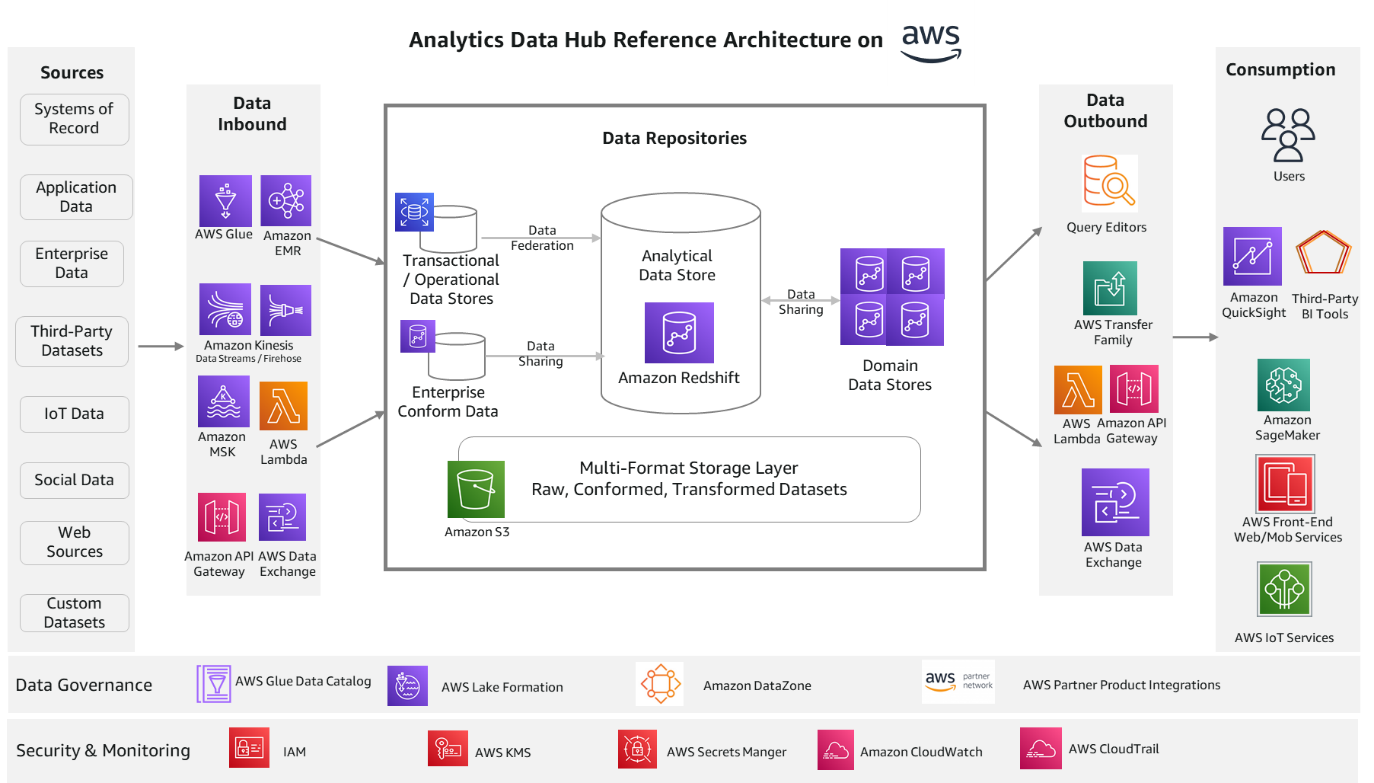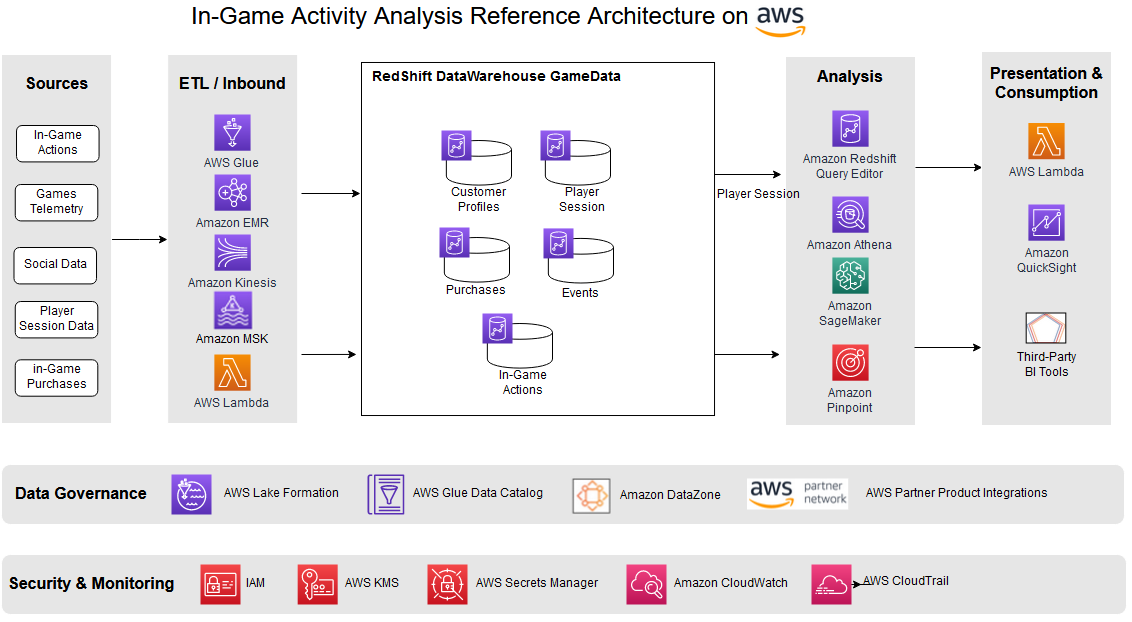Post Syndicated from Satesh Sonti original https://aws.amazon.com/blogs/big-data/combine-transactional-streaming-and-third-party-data-on-amazon-redshift-for-financial-services/
Financial services customers are using data from different sources that originate at different frequencies, which includes real time, batch, and archived datasets. Additionally, they need streaming architectures to handle growing trade volumes, market volatility, and regulatory demands. The following are some of the key business use cases that highlight this need:
- Trade reporting – Since the global financial crisis of 2007–2008, regulators have increased their demands and scrutiny on regulatory reporting. Regulators have placed an increased focus to both protect the consumer through transaction reporting (typically T+1, meaning 1 business day after the trade date) and increase transparency into markets via near-real-time trade reporting requirements.
- Risk management – As capital markets become more complex and regulators launch new risk frameworks, such as Fundamental Review of the Trading Book (FRTB) and Basel III, financial institutions are looking to increase the frequency of calculations for overall market risk, liquidity risk, counter-party risk, and other risk measurements, and want to get as close to real-time calculations as possible.
- Trade quality and optimization – In order to monitor and optimize trade quality, you need to continually evaluate market characteristics such as volume, direction, market depth, fill rate, and other benchmarks related to the completion of trades. Trade quality is not only related to broker performance, but is also a requirement from regulators, starting with MIFID II.
The challenge is to come up with a solution that can handle these disparate sources, varied frequencies, and low-latency consumption requirements. The solution should be scalable, cost-efficient, and straightforward to adopt and operate. Amazon Redshift features like streaming ingestion, Amazon Aurora zero-ETL integration, and data sharing with AWS Data Exchange enable near-real-time processing for trade reporting, risk management, and trade optimization.
In this post, we provide a solution architecture that describes how you can process data from three different types of sources—streaming, transactional, and third-party reference data—and aggregate them in Amazon Redshift for business intelligence (BI) reporting.
Solution overview
This solution architecture is created prioritizing a low-code/no-code approach with the following guiding principles:
- Ease of use – It should be less complex to implement and operate with intuitive user interfaces
- Scalable – You should be able to seamlessly increase and decrease capacity on demand
- Native integration – Components should integrate without additional connectors or software
- Cost-efficient – It should deliver balanced price/performance
- Low maintenance – It should require less management and operational overhead
The following diagram illustrates the solution architecture and how these guiding principles were applied to the ingestion, aggregation, and reporting components.

Deploy the solution
You can use the following AWS CloudFormation template to deploy the solution.
This stack creates the following resources and necessary permissions to integrate the services:
- Data stream – With Amazon Kinesis Data Streams, you can send data from your streaming source to a data stream to ingest the data into a Redshift data warehouse. Refer to Real-time analytics with Amazon Redshift streaming ingestion for information about configuring streaming ingestion.
- Database cluster – For this solution, we use an Amazon Aurora MySQL-Compatible Edition 8.0 version cluster. This will be your OLTP data store for transactional data. You will set up zero-ETL integration for ingesting transaction data to the Redshift data warehouse. Refer to Getting started guide for near-real time operational analytics using Amazon Aurora zero-ETL integration with Amazon Redshift for instructions on creating the integration. The required parameter groups for source and target are already created as part of the CloudFormation stack.
- Redshift cluster – This stack creates an Amazon Redshift Serverless workgroup and associated namespace. It also deploys a provisioned Redshift cluster. If you would like to work with Redshift Serverless, you can remove the provisioned cluster from the template and vice versa.
- IAM role – The stack creates an AWS Identity and Access Management (IAM) role with required policies and trust relationships.
- Network components – This includes a VPC, subnets, route table, and associations. You can customize these resources as per your organization’s rules.
Ingestion
To ingest data, you use Amazon Redshift Streaming Ingestion to load streaming data from the Kinesis data stream. For transactional data, you use the Redshift zero-ETL integration with Amazon Aurora MySQL. For third-party reference data, you take advantage of AWS Data Exchange data shares. These capabilities allow you to quickly build scalable data pipelines because you can increase the capacity of Kinesis Data Streams shards, compute for zero-ETL sources and targets, and Redshift compute for data shares when your data grows. Redshift streaming ingestion and zero-ETL integration are low-code/no-code solutions that you can build with simple SQLs without investing significant time and money into developing complex custom code.
For the data used to create this solution, we partnered with FactSet, a leading financial data, analytics, and open technology provider. FactSet has several datasets available in the AWS Data Exchange marketplace, which we used for reference data. We also used FactSet’s market data solutions for historical and streaming market quotes and trades.
Processing
Data is processed in Amazon Redshift adhering to an extract, load, and transform (ELT) methodology. With virtually unlimited scale and workload isolation, ELT is more suited for cloud data warehouse solutions.
You use Redshift streaming ingestion for real-time ingestion of streaming quotes (bid/ask) from the Kinesis data stream directly into a streaming materialized view and process the data in the next step using PartiQL for parsing the data stream inputs. Note that streaming materialized views differs from regular materialized views in terms of how auto refresh works and the data management SQL commands used. Refer to Streaming ingestion considerations for details.
You use the zero-ETL Aurora integration for ingesting transactional data (trades) from OLTP sources. Refer to Working with zero-ETL integrations for currently supported sources. You can combine data from all these sources using views, and use stored procedures to implement business transformation rules like calculating weighted averages across sectors and exchanges.
Historical trade and quote data volumes are huge and often not queried frequently. You can use Amazon Redshift Spectrum to access this data in place without loading it into Amazon Redshift. You create external tables pointing to data in Amazon Simple Storage Service (Amazon S3) and query similarly to how you query any other local table in Amazon Redshift. Multiple Redshift data warehouses can concurrently query the same datasets in Amazon S3 without the need to make copies of the data for each data warehouse. This feature simplifies accessing external data without writing complex ETL processes and enhances the ease of use of the overall solution.
Let’s review a few sample queries used for analyzing quotes and trades. We use the following tables in the sample queries:
- dt_hist_quote – Historical quotes data containing bid price and volume, ask price and volume, and exchanges and sectors. You should use relevant datasets in your organization that contain these data attributes.
- dt_hist_trades – Historical trades data containing traded price, volume, sector, and exchange details. You should use relevant datasets in your organization that contain these data attributes.
- factset_sector_map – Mapping between sectors and exchanges. You can obtain this from the FactSet Fundamentals ADX dataset.
Sample query for analyzing historical quotes
You can use the following query to find weighted average spreads on quotes:
Sample query for analyzing historical trades
You can use the following query to find $-volume on trades by detailed exchange, by sector, and by major exchange (NYSE and Nasdaq):
Reporting
You can use Amazon QuickSight and Amazon Managed Grafana for BI and real-time reporting, respectively. These services natively integrate with Amazon Redshift without the need to use additional connectors or software in between.
You can run a direct query from QuickSight for BI reporting and dashboards. With QuickSight, you can also locally store data in the SPICE cache with auto refresh for low latency. Refer to Authorizing connections from Amazon QuickSight to Amazon Redshift clusters for comprehensive details on how to integrate QuickSight with Amazon Redshift.
You can use Amazon Managed Grafana for near-real-time trade dashboards that are refreshed every few seconds. The real-time dashboards for monitoring the trade ingestion latencies are created using Grafana and the data is sourced from system views in Amazon Redshift. Refer to Using the Amazon Redshift data source to learn about how to configure Amazon Redshift as a data source for Grafana.
The users who interact with regulatory reporting systems include analysts, risk managers, operators, and other personas that support business and technology operations. Apart from generating regulatory reports, these teams require visibility into the health of the reporting systems.
Historical quotes analysis
In this section, we explore some examples of historical quotes analysis from the Amazon QuickSight dashboard.
Weighted average spread by sectors
The following chart shows the daily aggregation by sector of the weighted average bid-ask spreads of all the individual trades on NASDAQ and NYSE for 3 months. To calculate the average daily spread, each spread is weighted by the sum of the bid and the ask dollar volume. The query to generate this chart processes 103 billion of data points in total, joins each trade with the sector reference table, and runs in less than 10 seconds.

Weighted average spread by exchanges
The following chart shows the daily aggregation of the weighted average bid-ask spreads of all the individual trades on NASDAQ and NYSE for 3 months. The calculation methodology and query performance metrics are similar to those of the preceding chart.

Historical trades analysis
In this section, we explore some examples of historical trades analysis from the Amazon QuickSight dashboard.
Trade volumes by sector
The following chart shows the daily aggregation by sector of all the individual trades on NASDAQ and NYSE for 3 months. The query to generate this chart processes 3.6 billion of trades in total, joins each trade with the sector reference table, and runs in under 5 seconds.

Trade volumes for major exchanges
The following chart shows the daily aggregation by exchange group of all the individual trades for 3 months. The query to generate this chart has similar performance metrics as the preceding chart.

Real-time dashboards
Monitoring and observability is an important requirement for any critical business application such as trade reporting, risk management, and trade management systems. Apart from system-level metrics, it’s also important to monitor key performance indicators in real time so that operators can be alerted and respond as soon as possible to business-impacting events. For this demonstration, we have built dashboards in Grafana that monitor the delay of quote and trade data from the Kinesis data stream and Aurora, respectively.
The quote ingestion delay dashboard shows the amount of time it takes for each quote record to be ingested from the data stream and be available for querying in Amazon Redshift.

The trade ingestion delay dashboard shows the amount of time it takes for a transaction in Aurora to become available in Amazon Redshift for querying.

Clean up
To clean up your resources, delete the stack you deployed using AWS CloudFormation. For instructions, refer to Deleting a stack on the AWS CloudFormation console.
Conclusion
Increasing volumes of trading activity, more complex risk management, and enhanced regulatory requirements are leading capital markets firms to embrace real-time and near-real-time data processing, even in mid- and back-office platforms where end of day and overnight processing was the standard. In this post, we demonstrated how you can use Amazon Redshift capabilities for ease of use, low maintenance, and cost-efficiency. We also discussed cross-service integrations to ingest streaming market data, process updates from OLTP databases, and use third-party reference data without having to perform complex and expensive ETL or ELT processing before making the data available for analysis and reporting.
Please reach out to us if you need any guidance in implementing this solution. Refer to Real-time analytics with Amazon Redshift streaming ingestion, Getting started guide for near-real time operational analytics using Amazon Aurora zero-ETL integration with Amazon Redshift, and Working with AWS Data Exchange data shares as a producer for more information.
About the Authors
 Satesh Sonti is a Sr. Analytics Specialist Solutions Architect based out of Atlanta, specialized in building enterprise data platforms, data warehousing, and analytics solutions. He has over 18 years of experience in building data assets and leading complex data platform programs for banking and insurance clients across the globe.
Satesh Sonti is a Sr. Analytics Specialist Solutions Architect based out of Atlanta, specialized in building enterprise data platforms, data warehousing, and analytics solutions. He has over 18 years of experience in building data assets and leading complex data platform programs for banking and insurance clients across the globe.
 Alket Memushaj works as a Principal Architect in the Financial Services Market Development team at AWS. Alket is responsible for technical strategy for capital markets, working with partners and customers to deploy applications across the trade lifecycle to the AWS Cloud, including market connectivity, trading systems, and pre- and post-trade analytics and research platforms.
Alket Memushaj works as a Principal Architect in the Financial Services Market Development team at AWS. Alket is responsible for technical strategy for capital markets, working with partners and customers to deploy applications across the trade lifecycle to the AWS Cloud, including market connectivity, trading systems, and pre- and post-trade analytics and research platforms.
 Ruben Falk is a Capital Markets Specialist focused on AI and data & analytics. Ruben consults with capital markets participants on modern data architecture and systematic investment processes. He joined AWS from S&P Global Market Intelligence where he was Global Head of Investment Management Solutions.
Ruben Falk is a Capital Markets Specialist focused on AI and data & analytics. Ruben consults with capital markets participants on modern data architecture and systematic investment processes. He joined AWS from S&P Global Market Intelligence where he was Global Head of Investment Management Solutions.
 Jeff Wilson is a World-wide Go-to-market Specialist with 15 years of experience working with analytic platforms. His current focus is sharing the benefits of using Amazon Redshift, Amazon’s native cloud data warehouse. Jeff is based in Florida and has been with AWS since 2019.
Jeff Wilson is a World-wide Go-to-market Specialist with 15 years of experience working with analytic platforms. His current focus is sharing the benefits of using Amazon Redshift, Amazon’s native cloud data warehouse. Jeff is based in Florida and has been with AWS since 2019.






















 Satesh Sonti is a Sr. Analytics Specialist Solutions Architect based out of Atlanta, specialized in building enterprise data platforms, data warehousing, and analytics solutions. He has over 17 years of experience in building data assets and leading complex data platform programs for banking and insurance clients across the globe.
Satesh Sonti is a Sr. Analytics Specialist Solutions Architect based out of Atlanta, specialized in building enterprise data platforms, data warehousing, and analytics solutions. He has over 17 years of experience in building data assets and leading complex data platform programs for banking and insurance clients across the globe. Harshida Patel is a Specialist Principal Solutions Architect, Analytics with AWS.
Harshida Patel is a Specialist Principal Solutions Architect, Analytics with AWS. Raghu Kuppala is an Analytics Specialist Solutions Architect experienced working in the databases, data warehousing, and analytics space. Outside of work, he enjoys trying different cuisines and spending time with his family and friends.
Raghu Kuppala is an Analytics Specialist Solutions Architect experienced working in the databases, data warehousing, and analytics space. Outside of work, he enjoys trying different cuisines and spending time with his family and friends. Ashish Agrawal is a Sr. Technical Product Manager with Amazon Redshift, building cloud-based data warehouses and analytics cloud services. Ashish has over 24 years of experience in IT. Ashish has expertise in data warehouses, data lakes, and platform as a service. Ashish has been a speaker at worldwide technical conferences.
Ashish Agrawal is a Sr. Technical Product Manager with Amazon Redshift, building cloud-based data warehouses and analytics cloud services. Ashish has over 24 years of experience in IT. Ashish has expertise in data warehouses, data lakes, and platform as a service. Ashish has been a speaker at worldwide technical conferences.



 Tanya Rhodes is a Senior Solutions Architect based out of San Francisco, focused on games customers with emphasis on analytics, scaling, and performance enhancement of games and supporting systems. She has over 25 years of experience in enterprise and solutions architecture specializing in very large business organizations across multiple lines of business including games, banking, healthcare, higher education, and state governments.
Tanya Rhodes is a Senior Solutions Architect based out of San Francisco, focused on games customers with emphasis on analytics, scaling, and performance enhancement of games and supporting systems. She has over 25 years of experience in enterprise and solutions architecture specializing in very large business organizations across multiple lines of business including games, banking, healthcare, higher education, and state governments.






 Satesh Sonti is a Sr. Analytics Specialist Solutions Architect based out of Atlanta, specialized in building enterprise data platforms, data warehousing, and analytics solutions. He has over 16 years of experience in building data assets and leading complex data platform programs for banking and insurance clients across the globe.
Satesh Sonti is a Sr. Analytics Specialist Solutions Architect based out of Atlanta, specialized in building enterprise data platforms, data warehousing, and analytics solutions. He has over 16 years of experience in building data assets and leading complex data platform programs for banking and insurance clients across the globe. Yanzhu Ji is a Product Manager on the Amazon Redshift team. She worked on the Amazon Redshift team as a Software Engineer before becoming a Product Manager. She has a rich experience of how the customer-facing Amazon Redshift features are built from planning to launching, and always treats customers’ requirements as first priority. In her personal life, Yanzhu likes painting, photography, and playing tennis.
Yanzhu Ji is a Product Manager on the Amazon Redshift team. She worked on the Amazon Redshift team as a Software Engineer before becoming a Product Manager. She has a rich experience of how the customer-facing Amazon Redshift features are built from planning to launching, and always treats customers’ requirements as first priority. In her personal life, Yanzhu likes painting, photography, and playing tennis. Dinesh Kumar is a Database Engineer with more than a decade of experience working in the databases, data warehousing, and analytics space. Outside of work, he enjoys trying different cuisines and spending time with his family and friends.
Dinesh Kumar is a Database Engineer with more than a decade of experience working in the databases, data warehousing, and analytics space. Outside of work, he enjoys trying different cuisines and spending time with his family and friends.